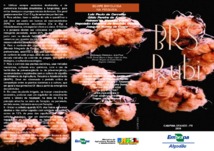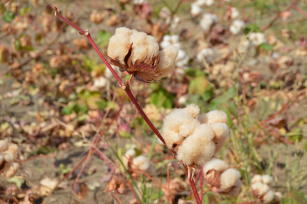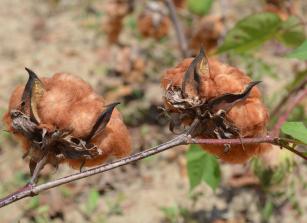Water-saving colored cotton jeans launched
Water-saving colored cotton jeans launched
The colored cotton cultivar BRS Rubi developed by Embrapa will be the raw material to manufacture denim, the fabric used to produce jeans. As it does not require dying, the new jeans use less water to be fabricated than the traditional indigo blue jeans.
Due to be launched on November 16, in São Paulo, at the Brazil Eco Fashion Week, the product will be the first Brazilian jeans manufactured from colored cotton. It was idealized by the company Natural Cotton Color, in partnership with National Industrial Learning Service (Senai), through an open innovation competition in 2016.
Francisca Vieira, the CEO of Natural Cotton Color, reports that the colored cotton jeans had great acceptance at Première Vision Paris, considered the main fair of the textile world, which showcases the main trends in fabrics. “If our denim has the same acceptance it had during the Première Vision Paris in the market, it will be a revolution in the jeans industry, especially because it is not blue and does not leave traces of dyes anywhere”, she states.
Conventional jeans use up to 11,000 liters of water
Another important point in favor of the new jeans is its water footprint, points out Luis Sávio Pinheiro, technology manager of Senai's Institute of Textile and Apparel Technology, where the fabric was developed. “Producing a pair of blue jeans in Brazil takes between 4,000 and 11,000 liters of water in the whole chain, from irrigation to processing and final touches to the product. Meanwhile colored cotton is not irrigated and does not require dyeing. Therefore, it consumes less water”, he compares.
The idealizer of the colored cotton jeans bets in the luxury market for the new product. “I have been seeking out brands that have high added value, which can give continuity to our work without submitting orders to be sewn in countries with slavery and child labor. We do not want to see our denim in the shelves of stores that pay dollar cents for the sewing”, declares the entrepreneur Francisca Vieira, who have already filed a request to patent the product at the National Industrial Property Institute (INPI). “We are looking for a brand to establish a partnership to produce the first lot of a thousand kilos, that is, approximately 2,000 meters of denim”, she reveals.
From the thread to the jeans
Senai's Institute of Textile Technology and Confection, in Paraíba state, created the textile threads, weaves, and, finally, the colored cotton denim. “Colored cotton fiber is a little shorter than the white one, but since for denim we use a thicker fabric, the length of the fiber was not an issue in the fabrication of the product”, reports Sávio Luis.
Besides denim, other new materials were developed, including a biodegradable elastane and a fabric that combines colored cotton with natural silk.
Growth projection for colored wool
The Embrapa Cotton socioeconomist Gilvan Ramos assesses that with the new product, the demand and the production of naturally colored cotton tend to grow. “The state of Paraíba still produces very little - 293 hectares were planted in 2019 and 391 tons of raw cotton were harvested there. This represents only 140 tons of wool ready spinning”, he evaluates.
Development made in partnership
The conception of the denim started from the Managing Committee of the Paraíba State Local Productive Arrangement of Colored Cotton Confections and Artifacts, which integrates entrepreneurs, farmers and their organizations and support institutions. The committee created in 2011 has the goal of articulating all the links involved in the cotton wool production chain. One of its most important results was the guaranteed purchase of colored cotton production, which gave farmers confidence to sow and feed the production chain in the state, a chain that comprises textile mills, clothes factories and fashion and decoration companies.
The committee is formed by: Embrapa, the Brazilian Association of the Textile and Apparel Industry (Abit), the Federation of Paraíba State Industries (Fiep), the Brazilian Trade and Investment Promotion Agency (Apex), the National Industrial Learning Service (Senai), the Brazilian Micro and Small Business Support Service (Sebrae), public and private banks, the Government of Paraíba, the Ministry of Agriculture, Livestock and Food Supply (Mapa) and the National Supply Company (Conab).
Photo: Senai
World market
Today China and the United States are the largest producers of colored cotton, with more than 100,000 hectares of plantation. According to the study conducted in 2017 by the Xinjiang Academy of Agricultural Sciences' Institute of Research on Industrial Crops, in China, the prospect is that there is a gradual increase in the demand for naturally colored cotton. The document finds that in 2036 it will represent about 30% of the world production of cotton, which is equivalent to six million tons of naturally colored cotton wool per year.
“The greatest limit of this technology is the range of colors, as earthy tones prevail, and do not allow greater fashion statements, but the possibility of new colors via biotechnology can increase this percentage further”, states the socioeconomist.
New colors
The Embrapa researcher Luiz Paulo Carvalho, responsible for the development of colored cotton varieties, reveals that he is close to obtaining rosy and orange shades. “We have lineages in the field that look promising regarding the colors. But we are still going to improve other traits before they are ready to be launched.” It is estimated that this stage could take about two years.
Embrapa already launched six colored cotton varieties in shades ranging from light green to light, dark and reddish browns. They are: BRS 200 Marrom, BRS Rubi, BRS Topázio, BRS Safira and BRS Jade.
Colored by nature
Meanwhile, Embrapa and research institutions from another 19 countries, following the example of the United States and Australia, keep on trying to obtain blue colored cotton through biotechnology, the so-called gene for jeans. “As blue colored cotton plants do not exist in nature, this process cannot be obtained through conventional breeding like our cultivars”, Carvalho explains. For him, blue cotton would be a great contribution from science to the fashion world, as it would significantly reduce the use of dyes in the textile industry. This would undoubtedly be a major advance, as the whole world manufactures jeans and a lot of dye and water is spent in producing the fabric", he asserts.
Translation: Mariana Medeiros
Edna Santos (MTb 01.700/CE)
Embrapa Cotton
Press inquiries
algodao.imprensa@embrapa.br
Phone number: +55 83 3182-4361
Further information on the topic
Citizen Attention Service (SAC)
www.embrapa.br/contact-us/sac/





